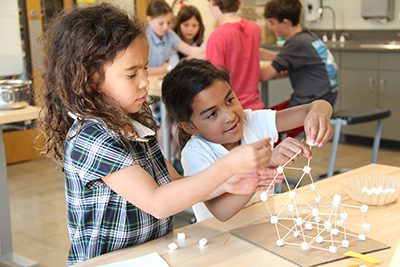May 9, 2019
 by Dr. Bill Hudson, Head of School
by Dr. Bill Hudson, Head of School
As I attend the concerts, art shows, and special grade-level events this month, I am reminded that May is a wonderful celebration of the maker mindset cultivated throughout the curriculum at MPA. I recently came across an article that explained the purpose of a makerspace. I found it descriptive of what happens in our own Makerspace and affirming of the pedagogy behind why we do what we do in that space. However, upon further reading and reflecting, I found that the maker mindset described extends to every classroom and the principles on which our school was founded.
Classroom teacher, university professor, and author John Spence defines a makerspace as “simply a space designed and dedicated to hands-on creativity,” he explains, “and the key thing there is they’re actually making something. Creativity is sometimes idea generation, it’s sometimes problem-solving. But (in) a makerspace, you’re actually going to create some kind of product.” It has been my experience that at MPA, one could easily take out the word makerspace in the above quote and insert “music classroom,” “art studio,” “physical education class,” “science classroom,” “playground,” etc. Throughout every area of the school, MPA teachers encourage, and the curriculum reflects, core values of design thinking including problem-based learning, critical thinking, divergent thinking, among other common values within the makerspace movement.
Spence stresses the importance of a maker mindset to succeed in the world in which we live. “There was a time when you could follow the formula: work hard at school, go to college, and climb a corporate ladder. But because of the complex global economy, because of the creative economy, the information economy, our students are going to have to navigate a maze. The ladder is now a maze. And because it’s a maze, what do they need in order to navigate that? They need to be able to engage in iterative thinking, creative thinking, critical thinking, they need to know how to pivot, how to change, how to revise, how to persevere. They need to solve complex problems.”
Senior presentations are always so very inspiring. I am awestruck at the growth, vulnerability, and reflectiveness of our seniors as they look back over their MPA careers and look forward to what lies ahead for them. So much of what we as a school aspire to is captured in these speeches and I find them incredibly inspiring, rewarding, and affirming. In many ways, our seniors can be like windows and mirrors. Their speeches serve as a window for us into their experience at MPA. As mirrors, they reflect how they have appropriated and incorporated the mission and values of the school into their lived reality.
For instance, senior Aneesh Syal recounted his journey through childhood, adolescence, and Upper School and how MPA made room for, and channeled, his imagination. He spoke of his rampant imagination and unstructured play. “Creating and playing with mixtures lets my imagination run wild because I am allowed to take what I know from my science and art classes and apply it to something that is actually tangible and not just in my imagination.” His maker mindset was encouraged and cultivated first by his parents and then at school. His advice? “… dreaming, playing, and creating gives us the ability to let our imagination run wild. In a world that seems so structured, sometimes closing your eyes and diving into a magical world is what instills a sense of joy within us all. Let your dreams run rampant.”
The maker mindset of senior Claire Hanson was apparent in her senior presentation as well. Again, encouraged and cultivated at school and at home, Claire reflected upon how she acquired a crucial maker trait of “failing fast.” She said, “The idea of ‘failing fast’ is a concept I have tried to embrace. Failing fast means you try new things, and if they work … then you pursue them, and if they don’t work, then you stop and move on … try something new. And that’s okay!” In the world ahead for our students, the propensity to fail often and fast in addressing complex problems is essential.
As we move through the month of May, I encourage you pause for a moment to consider our students—their accomplishments, activities, concerts, drama showcases, and art shows—as windows and mirrors of the maker mindset. May is Maker Month at MPA and a cumulative manifestation of a year-long acquisition of the mission and values of MPA.